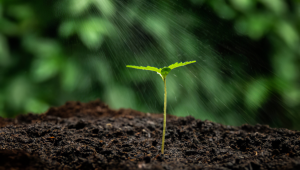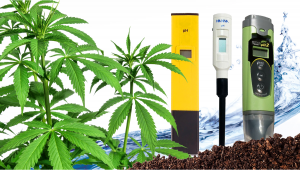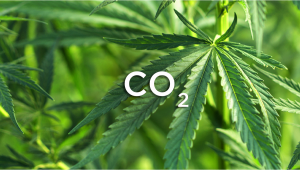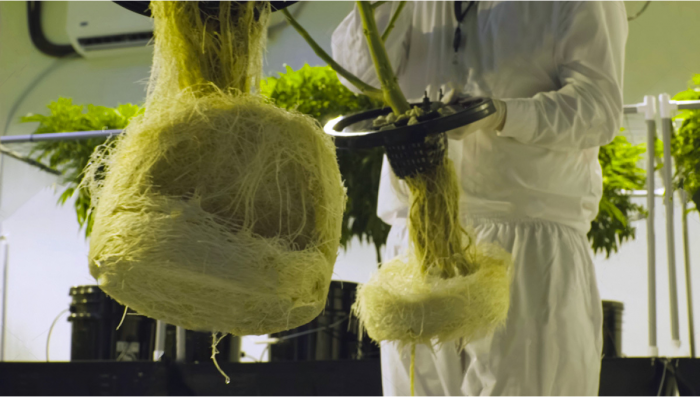The Importance Of Water Purity in Cannabis Grow

- 1. Why is water important?
- 2. What are the total dissolved solids (tds)?
- 2. a. Where do the solids come from?
- 3. Why measure the tds level of water?
- 4. A water quality checklist broken down
- 5. What is hard water?
- 6. What is soft water?
- 7. How to remove or reduce tds?
- 7. a. Reverse osmosis
- 7. b. Distilled water
- 7. c. Deionization
- 8. How to remove bacteria from water
- 9. Can i use rain water for cannabis plants?
- 10. Methods for watering your cannabis plants
- 11. Extra tips for purifying water
- 12. Other factors to consider
- 13. In conclusion
Water is not just water, depending on the source it can contain different minerals, metals, and other impurities that can end up affecting how your cannabis seeds grow.
1. Why is water important?
As you may know, water is the most abundant compound and one of the most important substances on Earth, all living things need water to survive, without water there would be no life on Earth.

Just like it’s vital to use, humans, it is also vital to all plants, including cannabis plants. Water makes up for around 85-95% of a plant's weight, not only are they made of water but they also use water more than anything else in their vital functions.
Nutrient distribution
There are different types of nutrients you can use, synthetic or organic, synthetic nutrients will feed the roots directly and organic nutrients that make the minerals available in the soil. In both cases, when you water your plants with a nutrient solution, the roots absorb it and transport it into the plant’s cell which is then used in combination with the other processes described above to produce sugars that are then used to grow and develop the stems, leaves, flowers, and seeds.
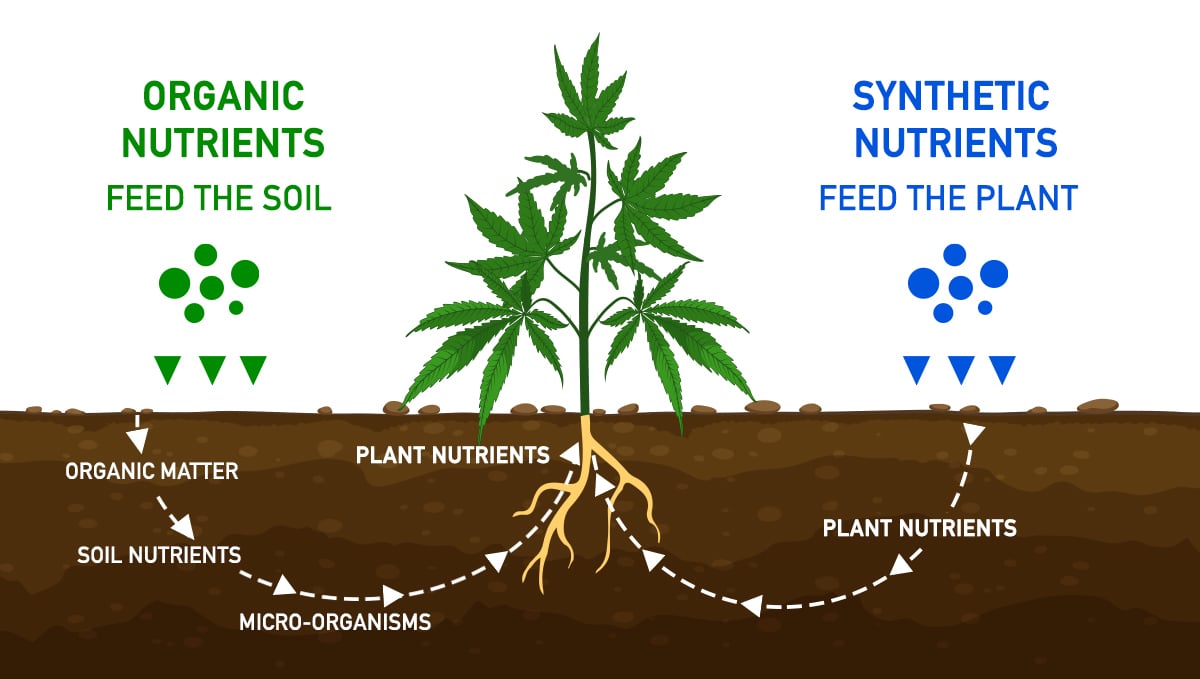
Now, these processes will be performed just fine with any kind of water but depending on the water source it may contain a lot of dissolved solids that can affect how well these processes work.
Transpiration
Transpiration is the process of water evaporation from leaves and stems, this happens because water is necessary to plants but only a small amount is used for growth and essential processes, around 97% is used in transpiration.
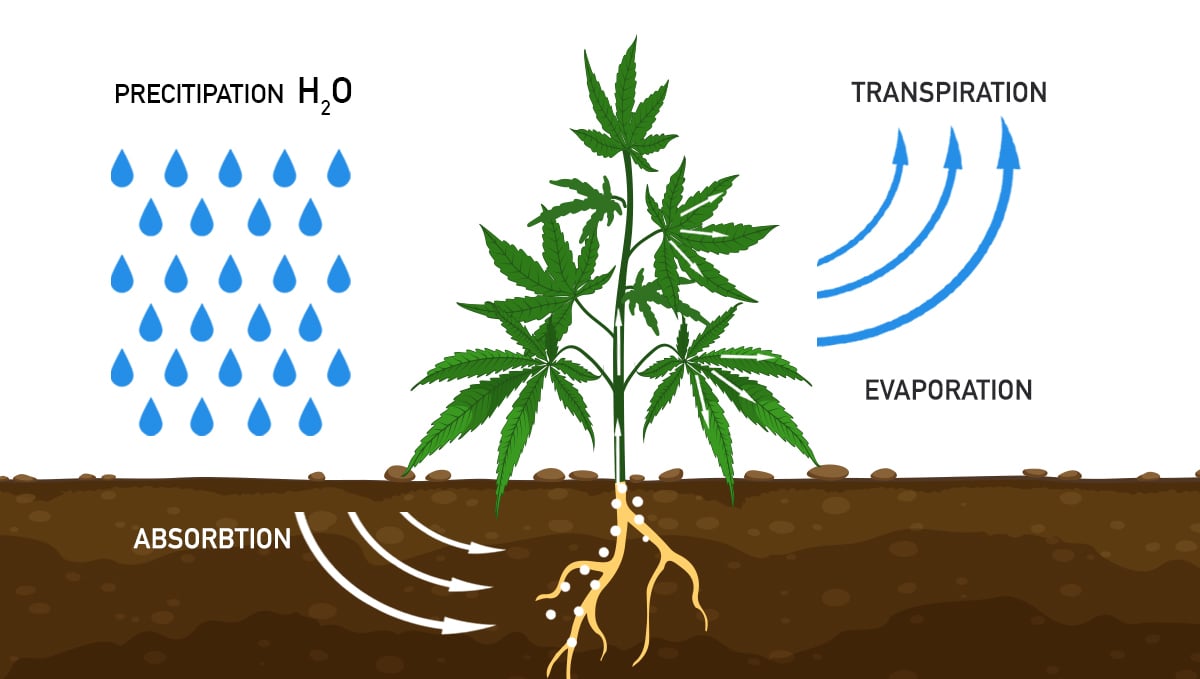
By evaporating the water, vapor is released in the atmosphere through the stomata, cooling the space around your plants, this helps keep an appropriate internal temperature and it’s essential because if the temperature is too high or too low, your plant will not be able to grow properly.
Photosynthesis
Photosynthesis is the process in which plants transform light energy into energy that can be used by them. Light energy is absorbed and used to convert carbons and the nutrients that are in the water into organic compounds like sugars that are used in plant development and growth.
2. What are the total dissolved solids (TDS)?
Dissolved solids refer to elements in water such as minerals, salts, metals, and anything dissolved in water other than water itself. Depending on the elements dissolved in water it will have a positive charge (cations) or a negative charge (anions) which can be measured by a TDS meter by measuring the electrical conductivity (EC) of water.
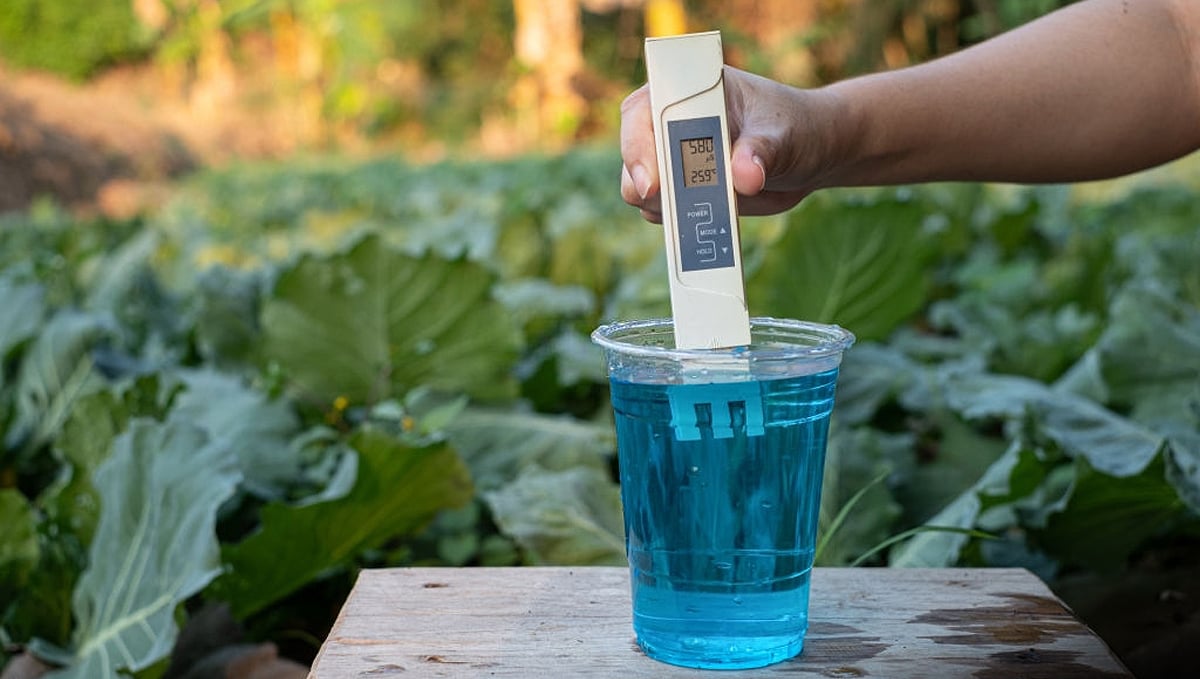
Have in mind that the EC and TDS are not the same thing but both can be calculated by knowing the exact value of one of them, to transform EC to TDS you have to multiply the value by 1000 and divide by 2, to transform the other way just multiply by 2 and divide by 1000. Also, remember that there’s no direct relation between pH and TDS but if the elements present in the water are acidic or alkaline, it can increase or decrease the pH level.
Where do the solids come from?
Dissolved solids can come from anything your water touches when traveling to your faucet, it may come from organic matter such as leaves, silt and from runoff water from farms or lawns that contain fertilizers and pesticides.
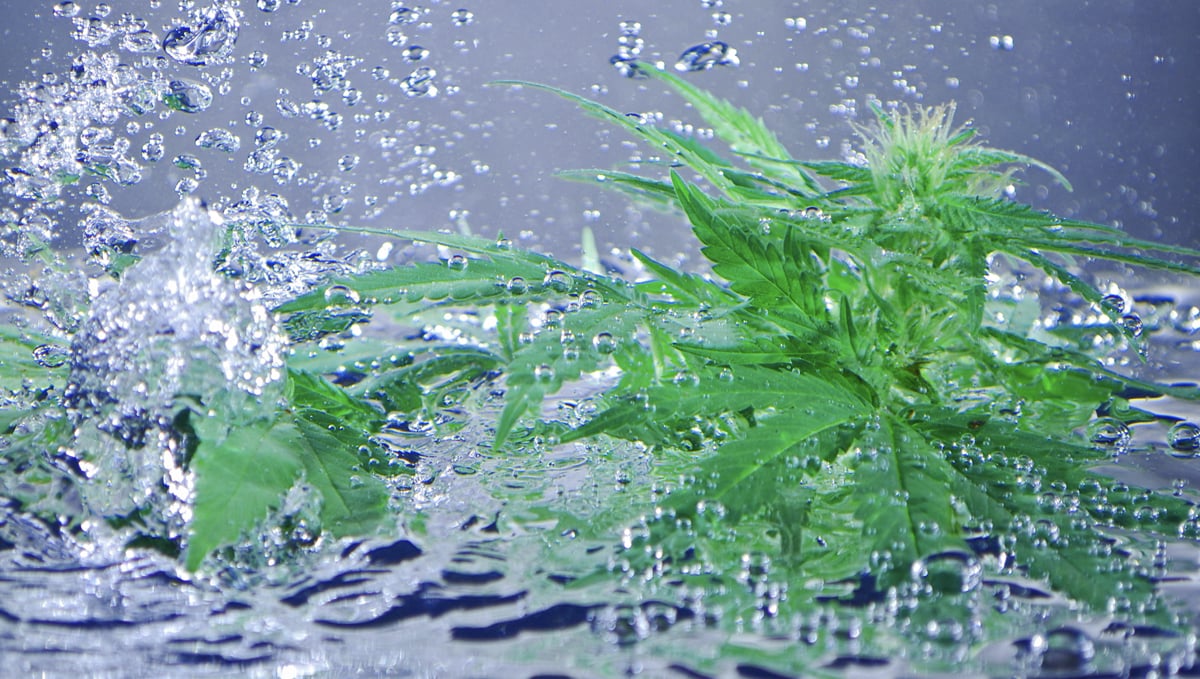
They can also come from inorganic matter such as rocks or even air that contains calcium, nitrogen, iron, and phosphorus among others, water can also pick up dissolved solids from the pipes it travels through, usually, water picks up lead and copper which is the metals those pipes are made out of.
Now, some of these metals and minerals are used by cannabis plants but depending on the type of nutrients and quantity you’re using, your plants can have problems, that’s why it’s essential to measure the TDS from the source.
3. Why measure the TDS level of water?
The US Environmental Protection Agency advises that a maximum of 500mg/L of total dissolved solids, higher than that it can be harmful for human consumption, and this also applies to plants.
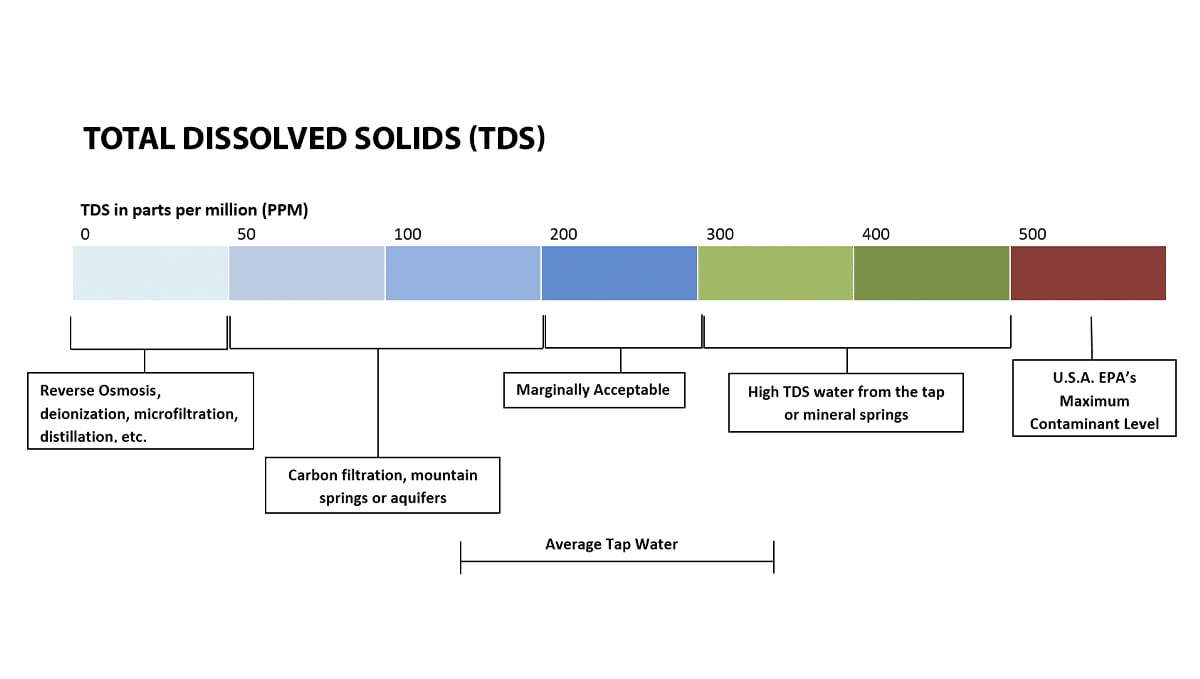
Depending on the elements present, watering your plants with water that has more than 1000mg/L can cause plants to have problems absorbing nutrients, and can cause stunted growth, and ultimately reduced yields.
Classification of Water
| Fresh Water | TDS = less than 1,000 mg/L | Mineral-rich, safe for consumption. |
|---|---|---|
| Brackish Water | TDS = 1,000 to 10,000 mg/L | Salt-rich can be consumed but not everyday. |
| Saline Water | TDS = 10,000 to 35,000 mg/L | High amounts of salt, can cause an overload of sodium. |
| Hypersaline Water | TDS = more than 35,000 mg/L | Extremely high amounts of salt, should not be consumed. |
Elements like potassium, chloride, and sodium have minimal effects on humans and are not considered harmful. But elements like lead, nitrate, and cadmium are toxic so it’s essential you know what comes in your water, although it’s not common to find toxic elements in tap water.
4. A Water Quality Checklist Broken Down
As already mentioned, the quality of water will vary from city to city, state to state, and country to country. Assuming that the water you are using is fine for cultivating cannabis without testing it first is a dangerous game to play, and could result in poor yields, unhealthy plants, and even crop death. So, what are the checks that every grower should run before they use their water to feed their weed crop?
Check your pH levels before every single feed.
This should be the last thing you do before feeding after you have added all the nutrients and additives to the feed water. When testing the pH of your water, make sure to first calibrate your pH meter against a known standard to be sure the meter is in good working order. Most purified water will have a pH of 7.0 and should have the exact pH range printed on the bottle. Cannabis plants like a pH range of between 5.8 and 6.2 (although some growers prefer a pH range of 6.0 to 6.5), but more on pH later.
Check the TDS or EC levels in your feed water before and after you add the nutrients and additives.
EC meters are much more common these days, and while they do electricity to measure they are not measuring electrical activity. EC pens measure the number of salts and minerals in the water, with water containing high levels of nutrients and fertilizers displaying higher readings. Water with too high of an EC reading is considered to be extremely dense, and as such makes it hard for the water to pass through the roots and into the vascular system of the plant. Water with too low an EC reading has the opposite problem, with the plants absorbing too much water in search of those precious nutrients that they need to grow and thrive. We will dive deeper into this later in the article.
If possible, order a water test.
While you can get meters to test both of these numbers, you can always grab a water test kit from your local hardware or garden supply store. This will give you a bit more of a detailed analysis of what is going on inside your precious aqua. If you are planning to run a large grow op it may be a good idea to order a water test from your local university or agriculture center. This will provide you with a much more detailed report of exactly what can be found in your water source.
5. What is hard water?
Hard water is water that contains a high amount of elements, such as calcium and magnesium, now these don’t present a threat to plants but can depend on the medium and nutrients you’re using.

When watering with hard water, the elements can end up coating the roots and soil and actually repel water instead of absorbing it. This way your plants can end up suffering from a nutrient build-up that can bring several problems such as overfeeding or nutrient lockout and even though you can fix it by flushing, it can be relatively hard.
6. What is soft water?
Soft water is water that also contains high amounts of impurities but instead of containing hard metals, it contains soft metals such as salt and sodium.
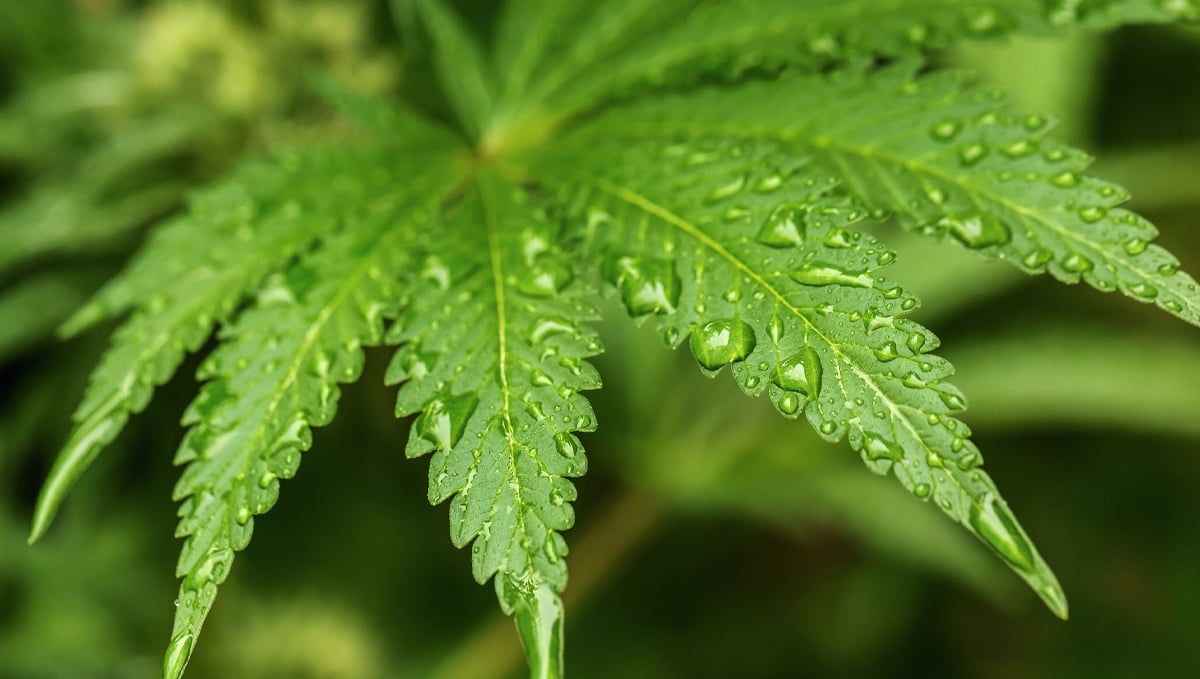
Unlike hard water that coats the roots and causes water to be repelled, soft water makes your plants intake more water but your plants are being fooled by thinking they’re being fed, so instead of getting hydrated, they're actually dying of dehydration.
7. How to remove or reduce TDS?
There are several ways to completely remove or at least reduce the amount of TDS in your water by filtering it, and it’s done with special equipment, although this doesn’t mean they’re super expensive.
By purifying or filtering your water, you can effectively eliminate bacteria, parasites and viruses, organic and inorganic chemicals, heavy metals, gasses, and other contaminants.
Reverse osmosis
Reverse osmosis is a way to remove contaminants from water, it works by forcing it with pressure through a membrane that removes the contaminants and provides clean water.
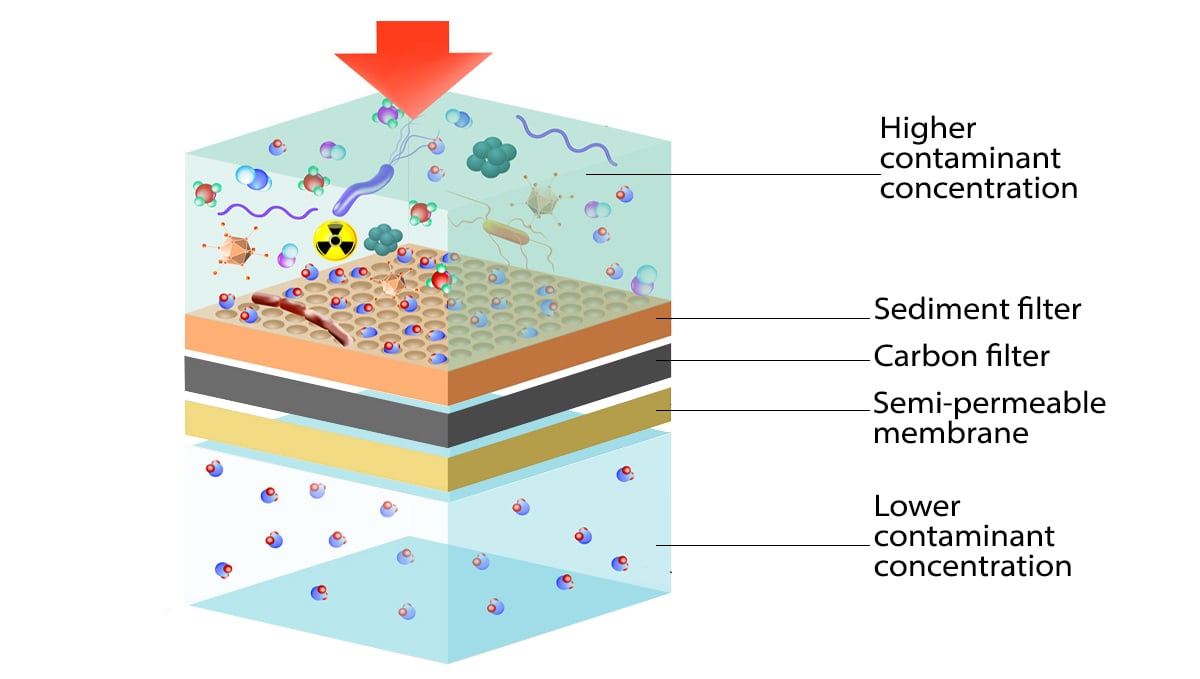
This system can have 3, 4, or 5 stages in which certain impurities are removed.
Each system contains the following type of filters:
- Sediment filter: Removes dust, dirt, and rust.
- Carbon filter: Removes or reduces organic compounds like chlorine and other elements that can give water a bad taste or odor.
- Semi-permeable membrane: Removes up to 98% of the remaining dissolved solid like minerals and metals.
Distilled water
Distilled water is a type of purification which is made by boiling water, after it boils, the vapor is then caught with a glass container and it quickly gets condensed and turned back into a liquid form.

The impurities that were in the water do not boil at the same temperature so they are left behind in the original container, this doesn’t remove all of the dissolved solids but it’s a really effective way and has been used for a long, long time.
Deionization
Deionization (aka demineralized water) is water that has had the impurities removed, this process works by using ion-exchange resins that bind to the impurities and filters them.
This type of purification produces high-purity water and is relatively quick but does not remove bacteria or viruses effectively.
8. How to Remove Bacteria From Water
Even city tap water can harbor some nasty bacteria. While this is often harmless to humans, the same can not always be said for our precious plants. Healthy cannabis plants that are watered with clean, bacteria-free water will produce - on average - 35% to 40% better yields than those that consume water that contains certain bacteria. Without having a comprehensive water report run, it can be very hard to determine if your water supply is bacteria-free or not. Most growers, especially beginners, do not bother with this. But, if you are looking to start a larger growing operation, it will definitely be handy to get the test done.The two main solutions for bacteria ladened water is to either run Ultraviolet Disinfection, which works by ripping apart the DNA of the bacteria, or Quantum Disinfection, which works by taking the electrons from the bacteria present in the water source, making them implode and disappear.
9. Can I use Rain Water For Cannabis Plants?
Rain water is “soft” and contains almost no minerals or salts so it’s a great water source and it’s 100% free. If you think about it, plants have been drinking rain water for thousands of years so if you want to collect rain water to water your plants there shouldn’t be a problem at all, right? Well, it depends.
Is rain water bad for cannabis?
Pure rain water is actually really good but it may not be safe for your plants if you collect it in places where the air quality index is high. This happens because raindrops can pick up sulfur dioxide, CO2, and mercury as they fall, which makes it unsafe. A good way to know if the rain water is safe is to check your city’s AQI (air quality index) on the web. Most big city’s AQI is fairly high so it’s possible that you’ll have to go to the countryside to be able to collect good rain water. As a guideline, an AQI ranging from 0 - 50 is considered to pose very little or no risk at all so if you check the AQI index average and it’s below 50, then you can go ahead and start collecting rain water but there are a couple of things to have in mind before using it.
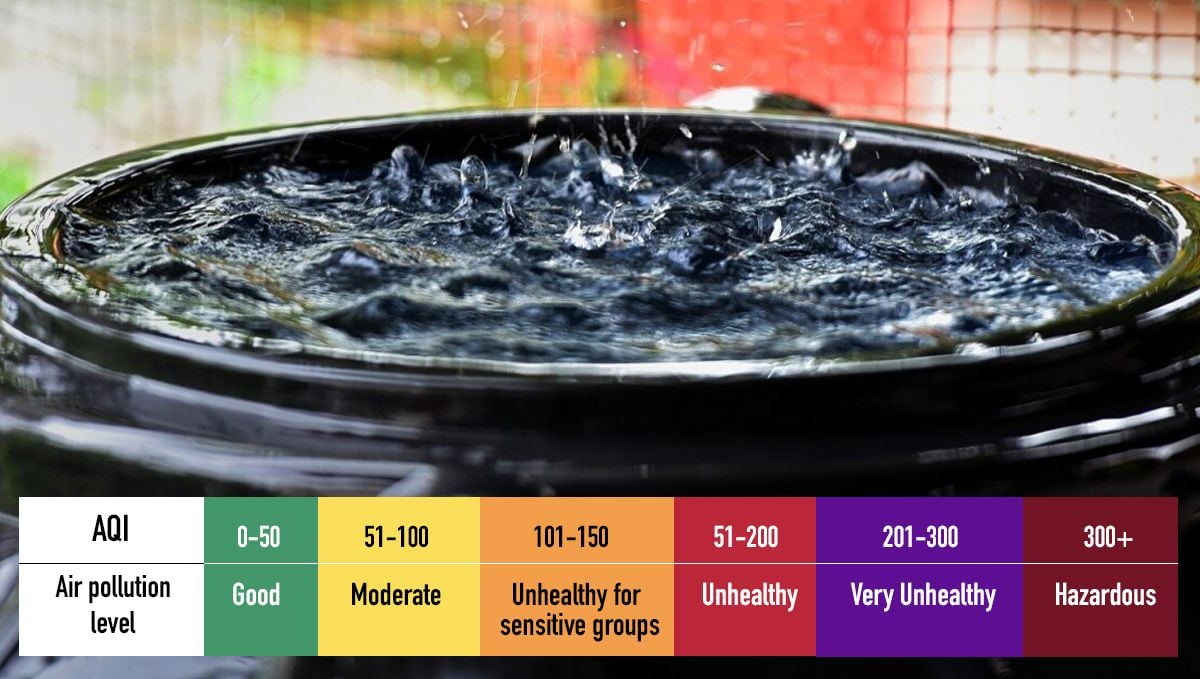
First of all, rain water’s pH can vary, especially if you collect it from different locations so make sure to always check and adjust the pH. If you don’t do it, the pH can drop drastically over time and cause a nutrient lock.
In second place, you should collect the rain as it falls. Avoid collecting rain water from the ground, gutter, or rooftop because impurities will bind to raindrops and can end up with all kinds of things such as animal hairs, mold, or chemicals. If you are forced to collect the rain water from the gutter, for example, it’s essential the gutters are clean, this means you’ll have to clean it every time you want to collect rain.
And, if you want to be extra safe, make sure to leave the water around 48hs under sunlight in order to make sure it’s even cleaner. Finally, remember that rain water contains fewer trace elements than RO water, so it’s very likely that your plants show calmag deficiency but this can be easily dealt with by adding calmag when mixing the nutrient solution and before testing the pH.
Rain Water Common Tips
For those of you that are still in doubt about using rainwater in your garden, here are the most common questions about using rainwater on cannabis plants.
Can I mix my nutrient solution with rain water?
Definitely. As long as you’ve collected the water correctly, measured, and adjusted the pH, you can use it just as you would use any kind of water.
What’s the best way to collect rain water?
The best way to collect water is basically the simplest. Just place a rainwater collector, a big bucket, or any type of plastic container outside and let it fill. Once it’s full just place a lid (or a fine mesh) and that’s it!
For how long can I store rain water?
If stored properly, rainwater can be stored for a long time. So if you want to store water for more than just a couple of days, it’s highly recommended to filter it with a 50-micron mesh to remove any possible mosquito eggs and any other impurities. Once your rainwater is filtered, store it in a hard plastic container and place a lid or fine mesh to avoid contamination.
Have in mind that you should check and adjust the pH of the rain water just before watering your plants and not before storing it because in most cases the pH will go up or down when stored.
How do I check and adjust the rain water’s pH?
Checing and adjusting the rain water’s pH is the same as any other type of water. So just get a pH pen and check the pH first, once you know the pH, it’s just a matter of using pH Down or pH Up solutions to adjust it to the desired pH. Remember that the atmosphere plays a huge role on rainwater’s pH.
For example, if it hasn’t rained for a while, there may be a lot of dust in the air, and dust (in some areas) has a high calcium content which can cause the rain’s pH to be 8.0 or higher but, after a couple of hours raining, the pH may be much much lower, reaching around 5.8 in just a couple of hours. This happens because the rain can basically clean off all the dust particles in the air, so after a couple of hours there wouldn’t be a high concentration of dust and the rainwater would be relatively clean. This is why you should check the pH always, no matter what.
Can I flush my cannabis plants with rainwater?
Of course. As long as you’ve checked and adjusted the pH to the desired level, you can use rainwater for flushing without any problems at all.
10. Methods for Watering Your Cannabis Plants
There are multiple ways in which cannabis plants are watered by hobby growers all the way up to large-scale farmers. The most important thing is to just get them well watered no matter the method, but some methods are better than others, depending on the style of grow. Outdoor grows rely mostly on rainfall or irrigation set up for additional feeding, but for indoor growth, there is a brunch of options to choose from. The most commonly used methods are:
Drip feeding
This involves setting up an irrigation system that feeds the plant's roots directly and consistently throughout the whole day. The water is pumped up to a thin drip tube which slowly releases the water and can be set to a timer. This system makes over watering almost impossible, and while it can take a bit of time to set up, it will save you a bunch in the long run
Flood tables
This method is used for full hydroponic setups. By sitting the hydro pots on a large yet shallow table that is flooded, the nutrients are delivered directly to the roots. This system can also be fully automated, and while it uses a fair amount of water, the excess can be recycled for later use and has been filtered.
Hand watering
The simplest way to water is by hand and requires almost zero setups. But, in the long run, you will have spent far more time watering than with either of the first two systems. It also has the potential for a lot of water, and in turn, nutrients, to be totally wasted. This is fine for small hobby grows, but not great for large-scale ops.
Aeroponics
A common hydroponics method that employs the use of spray nozzles to mist the exposed roots of the cannabis plants. This system uses far less water than other options and can result in amazing yields.
11. Extra tips for purifying water
- You can leave your water in a bucket at room temperature from 24hs up to a couple of days or have air stones in it to remove chlorine.
- You can remove calcium and magnesium by boiling water but without the proper equipment, it’s impossible to know how effective it is.
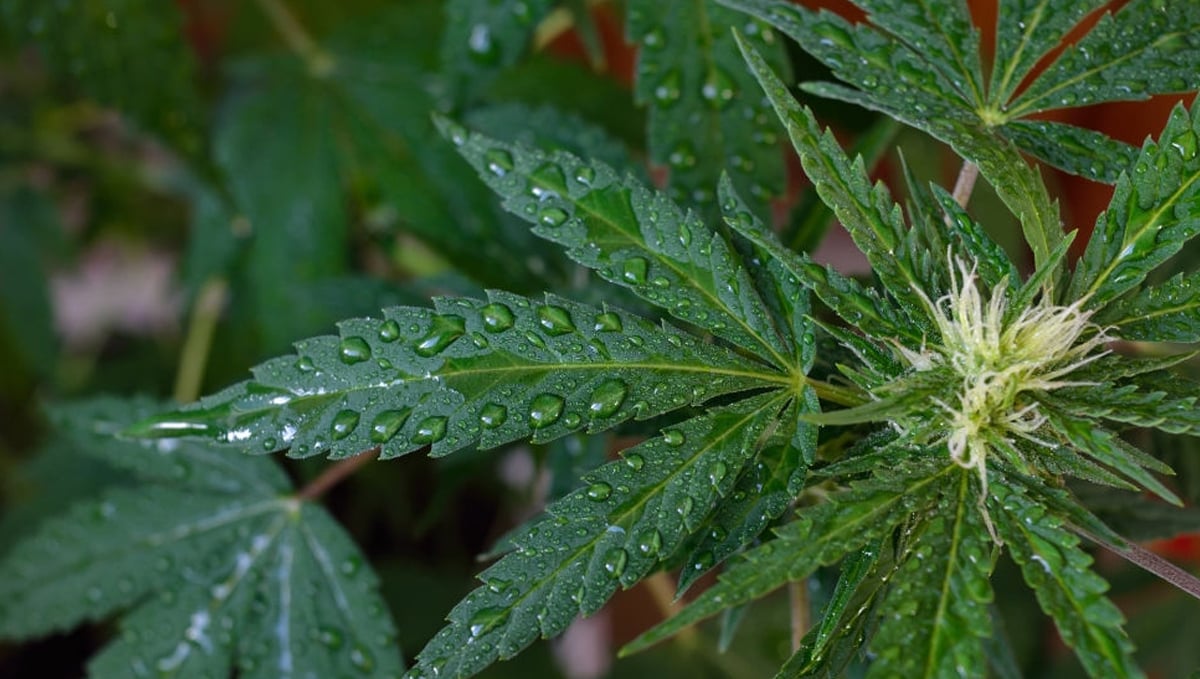
- Have in mind that the quality of water can change over time so it’s essential you measure it or request an analysis every couple of months.
- Even though our plants use some of the elements found in water, it’s essential you know the amount in it. The more impurities it contains, the less “good” nutrients your plant will absorb.
12. Other Factors to Consider
So as you can clearly see, water in general, but also the purity of said water, plays a huge role in cannabis cultivation success. But, water alone isn't enough to get the best out of your marijuana crop. If you want to maximize its growth and bud production, there are a few more essential elements and environmental controls that need to be carefully considered if you want the best chance at harvesting the type of yield we all dream of. Fortunately, if you opt for organic soil growing then at least one of these considerations can be eliminated due to the nutrients already present in the soil. But when it comes to hydroponic setup or coco-coir-based mediums, nutrition becomes especially important - make sure your crop is getting all it needs!
So yeah, it's not just water and nutrients that must be thought out when planning a successful cannabis crop. There's also lighting, temperature, humidity, and ventilation which are truly key components in creating an optimal cannabis growth environment. These are all easier to control indoors, but if you are planning an outdoor grow you still need to try and plan for these. Remember, if you give your plants the best chance of success then they will reward you with the highest yields possible, and the strongest potency the genetics can provide.
Nutrients
Healthy and robust cannabis plants require a combination of macro, secondary, and micronutrients in order to generate massive buds. Nitrogen (N), Phosphorus (P), and Potassium (K) are the primary macro-nutrients that must be supplied in the largest quantities - yet they are not all the crop needs. To reach its full potential, your plant should have access to the secondary and micro-nutrients that include magnesium (Mg), calcium (Ca), sulfur(S), boron(B), manganese(Mn), zinc (Zn), copper(Cu), iron(Fe), and molybdenum (Mo).
If you are planning to use a synthetic nutrient range then we suggest sticking to the larger, more well-known brands, and picking an option that is specific to your cultivation style. That means using coco nutrients for coco-coir, or hydro nutes for hydroponic systems. There are slight differences in the nutritional values of each nutrient option, so it is important to choose the right stuff. Leading nutrients brands include House & Garden, Canna, Botanicare, GHE, Advanced Nutrients, Fox Farms, General Hydroponics, Jack’s Nutrients, Technaflora, Mega Crop, and Nectar of the Gods. This is just a small cross-section of what's available, but all of these brands offer great products.
Oxygen and CO2
You are probably already well aware that all lifeforms, including cannabis plants, rely on oxygen and carbon dioxide for their survival. In cannabis, oxygen helps power metabolic activities whereas photosynthesis uses CO2. These two components are intricately linked with the lifecycle of cannabis so it's critical to ensure both are present at healthy levels in the root zone as well as inside the grow space itself.
Humidity
Humidity levels play a critical role in the health of your plant. Generally, the ideal humidity level should range between 40-60%. However, when germinating seeds and seedlings, it is best to keep closer to 70%, while full vegetative growth demands 50-60% humidity. As soon as flower production begins those levels can be slowly decreased. For most strains, especially indoor-grown crops with super dense bud formation, you want the humidity below 50% in the last four or five weeks before harvest to ensure no bud rot issues pop up.
Temperature
If you want to ensure the most robust growth in your cannabis plants, then 68-77°F (20-25°C) is the ideal temperature range. Anything outside of this limited range can be detrimental to the growth and health of the crop. Warmer temperatures may slow the growth speed considerably, while cooler ones may stop growth altogether. Outdoor growers will struggle with temperature regulation, but fortunately, with a greenhouse, you will have better control over heat which makes it easier to maintain an environment that’s conducive to steady development.
Lighting
Choosing the best light option is essential if you want your cannabis crop to hit those targets. Lighting plays a key role in promoting healthy growth for your cannabis crops; not only does lighting provide much-needed energy for photosynthesis but it also helps regulate the temperature inside greenhouses or indoor grows where natural light isn't available all year long. When setting up lights for your crops, make sure that they cover all areas evenly; additionally, use timers or motion sensors so that lights aren't shining unnecessarily during dark hours when they won't be doing any good!
While there are lots of lighting possibilities out there, only one truly makes sense in the current day: LED technology. In the past, HID light rigs were the best option for indoor cultivation, however, thanks to tremendous advances in LED technology over recent years, those days have passed. The list of reasons why LED lighting is now considered to be the industry standard include:
- Much lower power usage - Not only is this great for the environment, it also means you pay less for those annoying power bills that somehow turn up every 3 months.
- Lower heat production - LED panels run much cooler than HID rigs, which makes temperature control much simpler.
- Wattage efficiency is way higher - You get more actual light out of the diodes per watt than with traditional lighting rigs.
- Longer operating lifetimes - Light Emitting DIodes last for a much longer time than traditional bulbs, which means fewer trips to your local hydroponics store to buy new, expensive bulbs.
- Rather than just a narrow section of the lighting spectrum like with HID options - modern LED panels grant you access to the whole range of natural light. This gives you flexibility in adjusting your preferred spectrum or allowing your plants to bask in full-spectrum illumination.
Make sure to always buy a newer style of LED panel. Just as with everything in this life, there are quality products, and then there is the s** stuff. Always make sure that the one you buy offers the full spectrum of light, is dimmable and has quantum board tech.
Ventilation and Air Exchange
Adequate air exchange and ventilation are both essential to keeping your growing space cool, as well as supplying the plants with fresh CO2 and oxygen. If there is insufficient air exchange, temperatures will rise, CO2 levels will decline and mold may infect your precious crop. To ensure a constant airflow that keeps both your canopy temperature low and spore-free, investing in systems such as inline fans with ducting for air supply along with a few oscillating fans would be a pretty good idea.
Carbon filters are an essential element to ensure the air quality in your growing space is optimal. Additionally, they come with the added bonus of trapping all of those tempting fragrances that could otherwise escape. Discretion is always advised, even if you reside somewhere that allows cannabis cultivation.
The Growing Medium
There are three main grow mediums that cannabis cultivators usually go with:
- Soil
- Coco-coir
- Hydroponics
Each comes with its own set of advantages and disadvantages. For example, the soil is the most straightforward grow medium to use as it requires minimal monitoring of environmental parameters; however, soil blends can also be prone to fungi, disease, and pests. Hydroponic setups can be a little daunting to the novice growers among us, and they can be. But, there is a huge spread of hydroponic methods, with some of them being as simple as any other style of growing. They come in two main flavors - passive and active.
Passive forms of hydro don't employ the use of pumps or other methods of moving the water and nutrients around, whereas active forms do. Instead, they use the capillary action of the plants or a separate wick to draw the nutrient solution up to the roots. If you are just starting out then we do not usually suggest jumping strain into hydroponics, but if you are interested in the topic then check out our full hydroponics explainer right here. Coco-coir offers a happy medium between soil and hydroponics. It requires less monitoring than a hydro setup, while also draining much better than soil. It also has the added benefit of being able to hold the perfect amount of water, without becoming saturated. This one factor means that coco still allows for more oxygen to reach the roots than soil while still offering perfect root zone moisture levels.
13. In conclusion
Even though it might seem that it’s just water, water is the most essential compound for all living things on Earth, and despite growers not realizing this when they first start cultivating, water is super important in all the processes your cannabis plants need to perform in order to grow healthy and strong so it’s super important to know exactly what you’re watering your plants with.
Obviously, you can water with whatever you want but by providing better quality water, you will see a big difference in the end results.
If you filter or purify the water you use on your plants, please share with our fellow growers in the comment section below if you’ve seen big differences and if you found it worth it.
External References:
- Effect of different water quality parameters on acid requirement to lower water pH. - Bhardwaj, Sushant & Bishnoi, Arvind & Singh, Amandeep & Kumar, Narender. (2018).
- The uptake of alkaloids by plants from the soil is determined by rhizosphere pH. - Hijazin, Tahani & Radwan, Alzahraa & Lewerenz, Laura & Abouzeid, Sara & Selmar, Dirk. (2020).
- Hardness and total dissolved solids. - Gray, N. (2018).
- Improved Method for Measuring Total Dissolved Solids. - Gilmore, Kevin & Luong, Huan. (2016).










